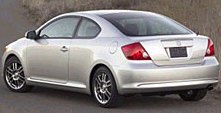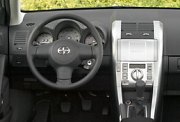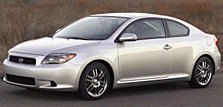|
 Toyota
established the "Scion" brand in USA as an attempt to lure young
customers.
Scion tC is the third model of the brand, after Scion xA (equivalent to
the Japanese Toyota ist) and xB (Toyota bB). tC is a hatchback coupe
derived
from the Avensis platform to compete in the "soft coupe" market with
Honda
Integra (Acura RSX), Hyundai Tuscani, Saturn Ion Quad-Coupe and
Chevrolet
Cobalt Coupe. Toyota
established the "Scion" brand in USA as an attempt to lure young
customers.
Scion tC is the third model of the brand, after Scion xA (equivalent to
the Japanese Toyota ist) and xB (Toyota bB). tC is a hatchback coupe
derived
from the Avensis platform to compete in the "soft coupe" market with
Honda
Integra (Acura RSX), Hyundai Tuscani, Saturn Ion Quad-Coupe and
Chevrolet
Cobalt Coupe.
It shares
the
2700mm wheelbase
with Avensis, ensuring a roomy cabin. Being a four-seater coupe, it
provides
plenty of legroom for the rear passengers, although headroom is
compromised
with the rear window. Panoramic glass roof allows a bright and airy
ambience.
By coupe standard the interior is unusually practical, not only because
it is actually a hatchback, but the 60/40-split rear seats can fold
down
to leave a flat loading space. In case you need to take long items such
as surf boards, the front passenger seat can fold down.
 The
interior design tries to be funky but in my eyes it is far from
successful.
Fake aluminum center console looks unpleasing, as is the 350Z-style
gauges.
Scion tC is built in Japan at the Tsutsumi plant, so build quality and
reliability are trustable. Nevertheless, the plastic materials used are
pretty low rent, obviously designed for the American market and to sell
at a very low price. In fact, the car is really cheap, priced at only
US$16,500
despite of a long list of standard equipment and the panoramic glass
roof.
It represents good value for money. The
interior design tries to be funky but in my eyes it is far from
successful.
Fake aluminum center console looks unpleasing, as is the 350Z-style
gauges.
Scion tC is built in Japan at the Tsutsumi plant, so build quality and
reliability are trustable. Nevertheless, the plastic materials used are
pretty low rent, obviously designed for the American market and to sell
at a very low price. In fact, the car is really cheap, priced at only
US$16,500
despite of a long list of standard equipment and the panoramic glass
roof.
It represents good value for money.
Suspensions
are
carried over
from Avensis, with struts at the front and double-wishbones at the
rear.
This setup has been thoroughly tuned by Toyota Europe and Lotus in
Avensis
thus ride and handling are promising. In the tC, the suspension tuning
is a little firmer, while wider and lower profile rubbers (215/45) and
17-inch wheels increase grip and sharpen handling further. However,
compare
with Honda Integra and many European hot hatches the tC still biases
more
towards comfort. Its suspensions soak up bumps effectively, delivering
a supple ride unfound at this price. The downside is a little more body
roll than desired. It would be better if Toyota can tune it to be
sharper.
 The
hydraulic power steering is accurate and well weighted. And its feel
improves
with speed, encouraging you to push harder. The same goes for the slick
and short-throw 5-speed manual gearbox. It comes from Camry, but
received
improved linkage and shorter gearing to speed up engine response. The
engine
is Camry’s 2.4-litre inline-4, with twin-cam 16 valves operated by
VVT-i
variable valve timing (at the intake side). The all-alloy engine has
twin-balance
shafts to counter-balance the typical vibration for big-capacity four
cylinder
engines, thus it revs smoothly until the 6200rpm red-line. It is not a
high-revving engine, but the plenty of cubic centimeters enables plenty
of power and torque - 160hp at 5700rpm and 163 lbft at 4000rpm. The
hydraulic power steering is accurate and well weighted. And its feel
improves
with speed, encouraging you to push harder. The same goes for the slick
and short-throw 5-speed manual gearbox. It comes from Camry, but
received
improved linkage and shorter gearing to speed up engine response. The
engine
is Camry’s 2.4-litre inline-4, with twin-cam 16 valves operated by
VVT-i
variable valve timing (at the intake side). The all-alloy engine has
twin-balance
shafts to counter-balance the typical vibration for big-capacity four
cylinder
engines, thus it revs smoothly until the 6200rpm red-line. It is not a
high-revving engine, but the plenty of cubic centimeters enables plenty
of power and torque - 160hp at 5700rpm and 163 lbft at 4000rpm.
At 1370kg,
Scion
tC is heavy
- good value for the amount of metal it offers! anyway, the 2.4-litre
engine
is still capable to push the car from rest to 60mph in 7.4 seconds.
Overall
speaking, Scion tC is practical, comfortable and fun to drive, if not
quite
sporty and attractive to eyes.
|